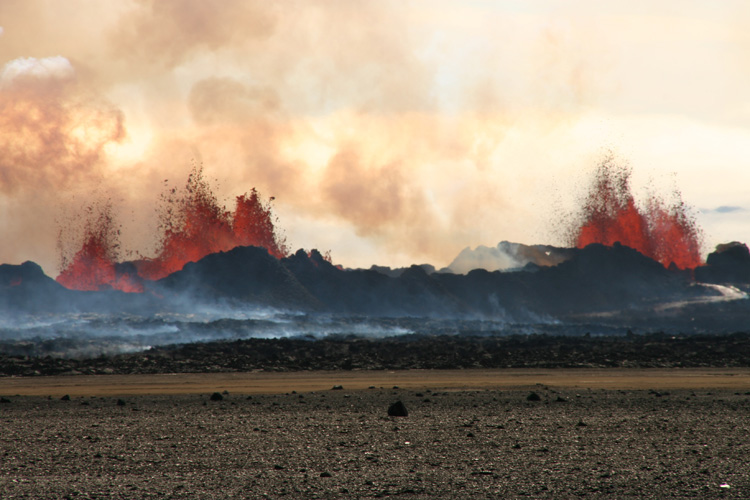Mega-Eruptions Linked to Most Mass Extinctions Over Past 500 Million Years

Mass extinctions litter the history of life on Earth, with about a dozen known in addition to the five largest ones — the last of which, at the end of the Cretaceous Period 66 million years ago, killed off the dinosaurs and 70% of all life on Earth.
A new study, led by scientists at Dartmouth College in New Hampshire, concludes that most of these mass extinctions had one thing in common: They occurred after mega-eruptions that spewed volcanic lava and toxic gases for hundreds of thousands of years, and some for as long as a million years.
The analysis linking mass extinctions throughout Earth’s history with major eruptions, characterized by lava and gas spilling from perhaps dozens of volcanoes and long fissure vents, confirms what many geologists have suspected for years. The most well-known mass extinction, referred to as the Cretaceous-Paleogene (K-Pg) extinction, was famously tied to a comet or asteroid impact in the Caribbean, but geologists have since found that the impact was preceded by a long period of eruptions in India that left behind flood basalts known today as the Deccan Traps. Massive amounts of sulfur dioxide emitted during the long-term eruption would have cooled the planet and caused the massive die-off seen in the fossil record.
“It’s been obvious to me for some time that there is this correlation between mass extinctions and flood basalt episodes,” said study co-author Paul Renne, professor-in-residence of earth and planetary science at the University of California, Berkeley, and director of the Berkeley Geochronology Center. “But nobody has approached it in the way that’s done in this work, which is to look at the actual rates at which the eruptions happened, which is presumably related to the rate at which climate modifying gases are injected into the atmosphere. And from the analysis, it looks like the rates really matter, especially for the really big ones.”

In fact, he said, there seems to be a threshold “beyond which you’re going to get a mass extinction and below which you might get some minor climate perturbations, but not something that extinguishes half of all life on the planet.”
One implication of the study is that the K-Pg extinction was predestined by the Deccan Traps eruptions. The bolide impact was simply the coup de grâce.
“Our results indicate that in all likelihood there would have been a mass extinction at the Cretaceous-Paleogene boundary of some significant magnitude, regardless of whether there was an impact or not, which can be shown more quantitatively now,” Renne said. “The fact that there was an impact undoubtedly made things worse.”
The impact of repeated eruptions over millennia
The new study, to be published this week in the journal Proceedings of the National Academy of Sciences, shows that four of the five biggest mass extinctions over the past 540 million years — the so-called Phanerozoic Eon — and a handful of other smaller, but still planet-wide, mass extinctions correlate with major lava events that produced large igneous provinces. Known meteor impacts do not correlate with the timeline of mass extinctions.
In the study, a “large” igneous province is one containing at least 100,000 cubic kilometers of magma. For context, the 1980 eruption of Mount St. Helens in Washington involved less than 1 cubic kilometer of magma. The researchers said that most of the volcanoes represented in the study erupted about a million times more lava than Mount St. Helens did. The Deccan Traps, for example — traps is a Swedish word for steps, because of the step-like structure of overlapping lava flows — erupted over a period of 1 million years and spewed lava flows for distances of at least 500 kilometers, in some places nearly 2 kilometers thick.
“The large, step-like areas of igneous rock from these big volcanic eruptions seem to line up in time with mass extinctions and other significant climatic and environmental events,” said the study’s lead author, Theodore Green, an undergraduate at Dartmouth College who conducted the research as part of the Senior Fellowship program. He now is a graduate student at Princeton University.
The researchers compared the best available estimates of flood basalt eruptions with periods of drastic species die-offs in the geological record. To prove that the correlation was more than chance, they examined whether the eruptions would line up just as well with a randomly generated pattern and repeated the exercise with 100 million such patterns. They determined that the chance that the correlation between eruptions and extinctions was merely random was one in 100.
“While it is difficult to determine if a particular volcanic outburst caused one particular mass extinction, our results make it hard to ignore the role of volcanism in extinction,” said Brenhin Keller, an assistant professor of earth sciences at Dartmouth and senior author of the paper. Keller was a postdoctoral fellow with Renne between 2016 and 2019.
Flood basalt eruptions aren’t common in the geologic record, said Green. The last one of comparable, but significantly smaller, scale happened about 16 million years ago in the Pacific Northwest, producing what’s known as the Columbia River Basalt Province. According to Renne, the eruptions are accompanied by massive releases of carbon dioxide, which warms the atmosphere, as well as sulfur dioxide, which cools the atmosphere. Recent evidence indicates that the cooling that leads to a mass extinction is often preceded by warming because the CO2 is emitted first because of its lower solubility in magma than in sulfur.
Renne noted that improved dates for flood basalt events were key to providing better estimates of the rate of eruptions, which enabled the study.
“The punch line is that our ability to draw these kinds of quantitative conclusions have been limited by the availability of high precision geochronology data,” Renne said. “So, this is a poster child for the importance of geochronology.”
Note: Some of this text comes from a press release distributed by Dartmouth’s Office of Communications.
